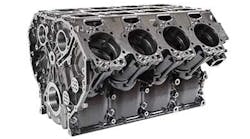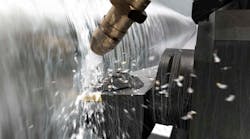A breakthrough in coating technology has resulted in a physical vapor deposition (PVD) aluminum oxide (Al2O3) coating for difficult-to-machine materials with the thermal resistance of traditional chemical vapor deposition (CVD) coatings.
Two principal coating processes for indexable inserts are the chemical vapor deposition process and the physical vapor deposition process. The chemical vapor deposition process involves high temperatures and produces relatively thick coatings with a high degree of wear resistance and coating adherence. Inserts coated by this process cope well with heat, they tolerate long insert engagement times and they produce large chip thicknesses.
The physical vapor deposition process involves a lower temperature and produces thinner coatings that have high toughness and are more suitable for sharper cutting edges. PVD-coated inserts cope well with instability and more demanding chip evacuation from the machining zone as well as multiple tool exits from the workpiece such as those encountered in milling.
Aluminum oxide is an attractive coating for a growing number of applications because it provides very good outer thermal and chemical protection for the insert substrate.
However, until a couple of years ago, Al2O3 coatings could be deposited only by the chemical vapor deposition process. Then, the cutting material developers at Walter (www.walter-tools.com) developed a process for depositing Al2O3 in a physical vapor deposition process. Prior to the development of the new coating process, it was impossible to apply aluminum oxide at a lower temperature.
The ability to coat Al2O3 with a physical vapor deposition process is particularly important for the cutting of stainless steel and high-temperature alloys that require positive insert geometries with sharp cutting edges. The thicker chemical vapor deposition coatings tend to dull the cutting edge and the high temperatures of the process can degrade the carbide. However, a thin physical vapor deposition coating maintains a sharp cutting edge and the lower coating process temperatures do not damage the carbide.
Coatings of physical vapor deposition aluminum oxide combine the toughness of conventional multilayer physical vapor deposition coatings on a titanium nitride (TiN), titanium aluminum nitride (TiAlN) or titanium carbo-nitride (TiCN) base with the exceptional thermal resistance of chemical vapor deposition coatings in one product.
Walter has been producing indexable inserts with physical vapor deposition aluminium oxide coatings for use on milling cutters for some time. Now, this high performance coating also is available on WSM30 indexable inserts for turning applications.
“There has never been a cutting product for turning with a toughness/hardness ratio like this, or tool life and process reliability characteristics that even come close,” Patrick Nehls, product manager for Walter products, said.
To ensure that the new inserts match a range of application requirements, the WSM30 product line includes all standard insert shapes in positive and negative geometries.
“Since the new PVD-Tiger truly comes into its own with problem-making materials, its primary application fields include high-alloy and stainless steels as well as materials with difficult cutting properties such as titanium alloys, or even superalloys like Inconel,” Nehls said. Secondary applications also include highly discontinuous cutting on low and high-alloy steels. Walter has included a variant of the cutting material, designated WSM33/WSP43, that has been optimized for grooving operations in its Walter-Cut grooving program.







